Content in flasks
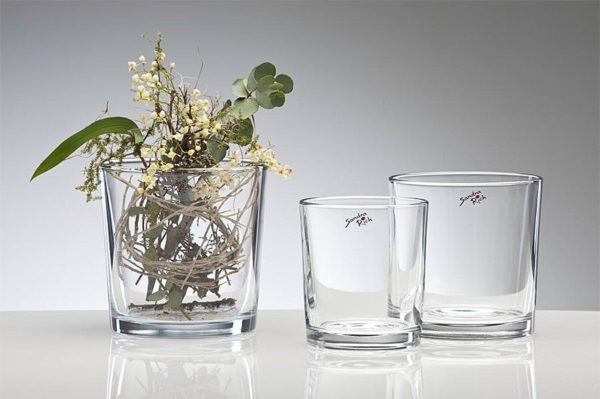 The difference lies not only in their beautiful blooms, but also in breeding methods. While many flowers grow on the ground, orchids grow from tree bark, clinging to it. They receive useful components and moisture with the help of aerial roots. Moisture comes from air or fog, and useful components from their own residues, which accumulate in the bark of the tree. But such a process takes place in the humid tropics, where the habitat for orchids is very suitable. It is impossible to create such an atmosphere in room conditions. There is more than one method for growing an orchid:
The difference lies not only in their beautiful blooms, but also in breeding methods. While many flowers grow on the ground, orchids grow from tree bark, clinging to it. They receive useful components and moisture with the help of aerial roots. Moisture comes from air or fog, and useful components from their own residues, which accumulate in the bark of the tree. But such a process takes place in the humid tropics, where the habitat for orchids is very suitable. It is impossible to create such an atmosphere in room conditions. There is more than one method for growing an orchid:
- growing in water - hydroponics;
- orchid without substrate and liquid;
- cultivation in soil.
If the roots of the plant are constantly in the liquid, then their rotting will begin. Therefore, they should not be completely submerged, but above the liquid. It is not necessary to switch to content in a flask right away, especially with regard to the flower itself:
- First, you need to pull it out of the ground, peel the roots, immerse it in water for a couple of days, and then dry it the next day. It is not necessary to drain the liquid completely, but so that the roots are still immersed in it by one centimeter.
- After a week, the orchid can be left in water for several days, but one day should be allowed to dry.
- After that, leave the phalaenopsis in the water for the whole time, changing it and observing the condition of the roots. If they change color to silver, then the flower needs to be watered.
At this time, the growth of new aerial roots will be noticeable, and green shoots will begin to appear on the old ones.
Note: With this method, growing can be difficult due to root rot. To cope with it, the flower needs to be pulled out of the water for a day and the roots are treated with a fungicide .. If algae have appeared on them, then you should not get rid of them, as this helps air exchange
A small part of the roots die off if the habitat has changed to water, and instead of them appear those that are adapted for the plant to stay in water
If algae have appeared on them, then you should not get rid of them, as this helps air exchange. A small part of the roots die off if the habitat has changed to water, and instead of them appear those that are adapted for the plant to stay in water.
To prevent the appearance of fungus, you need to use a semi-hydroculture - an unusual substrate that does not give the flower any nutritional components, but keeps it in a standing position. The flower receives all its nutrition through fertilizers, which are diluted in water. They are easily assimilated, and therefore do not spend a lot of energy, directing it to development.
Possible problems
Novice gardeners can face a number of difficulties when growing an unusual plant. Ignoring the problems that have arisen can lead to his death. Experts identify a list of the most common problems during orchid cultivation and how to solve them.
- Decay of foliage - improper watering. In case of damage to the trunk by rot, the plant cannot be saved.
- Withering - damage to the root system by dangerous insects.
- Mold build-up - low light level.
- Mechanical damage to the root system is a violation of the transportation rules.
- Root decay is a violation of the irrigation regime.
- Musty smell - non-observance of ventilation rules.
- Salt deposits and algae - non-compliance with sanitary standards and irregular washing of the vessel.
- Soft foliage - the presence of infection in the substrate or drainage.
Particular attention should be paid to the most common diseases of this plant:
- spotting;
- fusarium;
- bacterial rot;
- viral diseases.
Among the dangerous insects, the following types should be distinguished:
- thrips;
- scabbards;
- mealybug;
- spider mite.
For the correct transplant of an orchid into a glass flask, see below.
Care
Consider caring for an orchid in glass at home. Caring for a plant in a glass vase does not differ much from the traditional caring for an orchid in a substrate, but at the same time it has a number of nuances that must be known and taken into account. First of all, this applies to:
- The vase itself;
- Her material;
- Forms;
- And the place of residence of the plant.
Watering
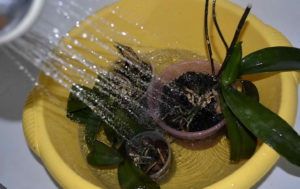 Watering a plant in a glass vase is no different from watering an orchid that grows in a regular pot or planter. The procedure is elementary: you need to carefully pour water into the vase in such an amount that the roots are completely immersed and moistened. The water should be:
Watering a plant in a glass vase is no different from watering an orchid that grows in a regular pot or planter. The procedure is elementary: you need to carefully pour water into the vase in such an amount that the roots are completely immersed and moistened. The water should be:
- Soft;
- Defended;
- With a minimum content of mineral salts.
This is important, first of all, for the delicate roots of the orchid, and will also contribute to the preservation of the decorative effect of the glass. After all, mineral salts after evaporation of water form a plaque, which is perfectly visible and does not look very attractive.
Advice! It is ideal to use rain or melt water, of course, only if the process of collecting precipitation was carried out in an ecologically clean region.
After 30-45 minutes, the water must be carefully drained
Do this with the utmost care, as:
- Wet glass is very slippery;
- The vase can accidentally slip out of your hands;
- Crash and injure you or those around you with shrapnel.
Make sure that no water remains in the vessel after draining. On average, the frequency of watering is:
- 2-3 times a week in warm weather;
- And once a week if it's cloudy outside.
It is always necessary to monitor the plant and take into account its current needs. On hot summer days, watering can be done daily. It is better to choose the time for the procedure in the first half of the day, so that by the evening the plant has time to dry out.
Top dressing and pest control
In natural conditions, feeding occurs naturally, when rain washes away from the bark of trees the humic substances formed on its surface directly onto the roots of the epiphyte. Therefore, when grown in indoor conditions, these plants require competent and metered feeding.
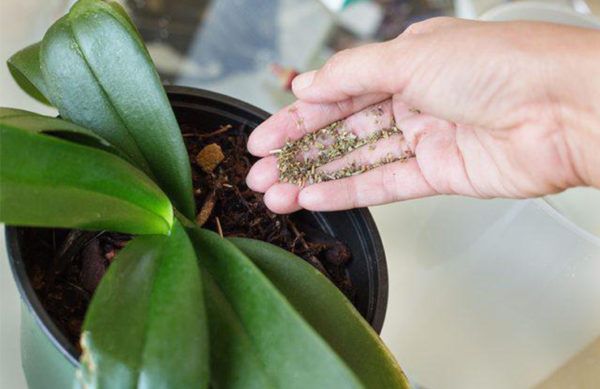
Orchid feeding is best done after flowering.
The most important thing to remember: it is better to carry out frequent fertilizing with a weak solution of fertilizers than rare, but strong ones. This is also explained by the same feeding features of orchids in nature. After all, rain in the tropics washes away a not very rich layer of substances, but it does it quite often.
In practice, this means that the orchid should be fed with liquid fertilizers once every 1-2 weeks at ¼ of the concentration indicated on the package during the active growing season and the green mass gain.
Advice! Before the procedure, it is necessary to moisten the plant roots with water to minimize the risk of burns with a fertilizer solution. Top dressing has proven to be effective, alternating with root dressings.
Pest treatments are carried out with diluted insecticides from a sprayer. Use a fine mist sprayer. It is necessary to process all parts of the plant (from all sides), except for flowers.
How can I keep my roots healthy?
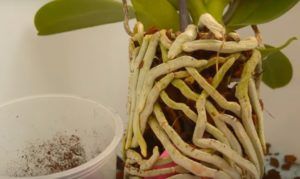 The best prevention of disease is to maintain optimal plant hygiene. In this case, it is necessary:
The best prevention of disease is to maintain optimal plant hygiene. In this case, it is necessary:
- Select a container size sufficient so that the roots of the plant fit freely inside;
- And also there was the possibility of ventilation and free access of air inside.
Unacceptable:
- Hypothermia of the roots;
- As well as debris and dirt inside the vase.
Remove dead leaves and roots from the plant in time.
Airing
It is enough to periodically remove the plant from the container and leave it in free space for a while. You can do this:
- While swimming;
- Or when you need to wash a vase from accumulated dirt.
Attention! Sometimes orchid roots can stick to the walls of the vase, so care must be taken when removing the plant from the container.
Treatment
The vase must be washed periodically, as the following accumulates on the inner walls:
- Algae layer;
- And mineral deposits.
The disinfection procedure or prophylaxis can be carried out using:
- A weak solution of potassium permanganate (of course, the plant should be removed);
- Or fungicides.
This orchid is susceptible to diseases such as:
- Spotting, which can be caused by excessive moisture in the substrate or in the air. In diseased plants, wart-like spots form on the underside of the leaf. It is often caused by fungal diseases that actively develop in warm and humid rooms. At the same time, rounded black spots appear on the upper side of the leaves. Orchids fight spotting by creating a favorable environment for the flower. When planting plants, the substrate is disinfected. Wanda is poured with water in which special antifungal drugs such as Trichodermin or Fitosporin are dissolved.
- Rot caused by waterlogging of the substrate. Most often, the disease progresses on cool days or when using containers unsuitable for an orchid. With this disease, rotting of the roots and stems is observed. Flower tissues soften and turn black. Very quickly, the plant turns yellow and dies. To combat this disease, the substrate is disinfected before planting the orchid. The plant is watered in accordance with the requirements of agricultural technology. The drug "Maxim" is added to the water.
| Manifestation | Cause | Elimination method |
| The leaves have round black markings along their entire length. | Fungal infection. | Treat infected areas with fungicide. Reduce the frequency of watering to 1 time per week, maintain a constant temperature of 23 ... 25 ° С. Cover with cloth, avoid bright light. |
| The horse system rots, becomes covered with a black coating and dies. The stem with leaves dries up. | Bacterial rot. | Remove the infected areas, cover the cut sites with phytosporin. Replace the soil and disinfect the container. Antibiotics (tetracycline) are also effective in the proportion of 1 gram per liter. |
| Black dots protrude on the outside of the leaf, the stem may be covered with brown lines. | Viral infection. | It is impossible to completely cure. Dispose of the infected plant to prevent spreading the infection. |
| Small green insects appear throughout the orchid. The stems and leaves wither, the plant dies. | Aphid. | Increase the humidity, treat the flower with soapy water or lemon peel tincture. Special intestinal preparations (Intavir, Aktofit) are best suited to combat the pest. |
| Small beige pests on leaves, peduncles, buds and stems. White bloom and waxy deposits. Wanda fades. | Mealybug. | Remove growths, affected parts of the plant. Treat the bulb with an alcohol solution, remove parasites. Aktara, Mospilan, Aktellik, Calypso are great for wrestling. |
| Small voids appear on the leaves and stem. Yellow spots appear, shoots die off. | Shield. | A solution of soap and alcohol, fern tincture and chemicals such as Permethrin, Bi 58, Phosphamide, Methylmercaptophos will help get rid of the pest. |
Growing orchids in glass pots (vases)
Although Wanda looks very elegant in this form, such content is suitable for him very conditionally. The reason is that only the roots of the plant should be in the flask behind the transparent glass, while the beard should be freely in space.
Tall vases are not suitable for these purposes - the plant should not be completely contained in the container, otherwise it suffers from stuffiness, and there is also an increased risk of decay.
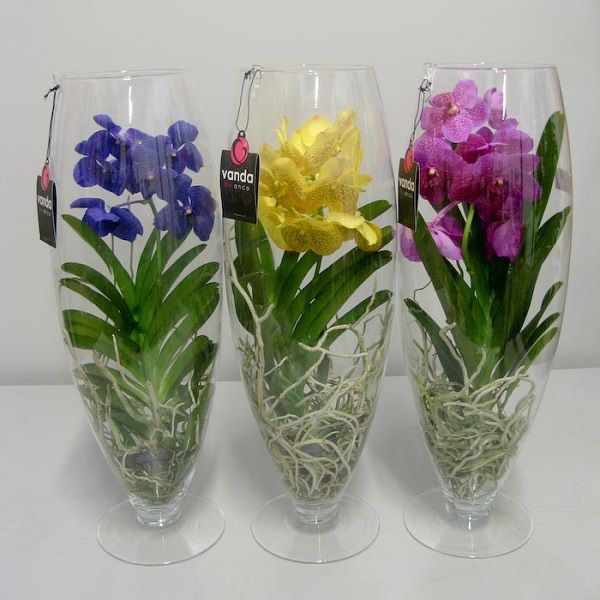
With such a cultivation, the orchid suffers from a lack of air.
Microclimate
Vase content has its advantages. A humid microclimate is formed in a glass flask, which is very beneficial for the roots of the plant, since in nature it grows in a very humid climate. Be careful, however, because the glass cools quickly and can cool the roots. Cold and moisture can cause mold and rot.
As already mentioned, tall, elongated glass pots are not suitable for wanda, but wide, in the form of glasses, will do. The size should be large enough for the roots to fit freely inside. The plant itself from the base of the rosette should be on the surface, flush with the edges of the vase, and not buried inward. You can fix the vanda in this position with a wire.
Attention! You can grow a vanda in a plastic container. A large, cropped bottle will do.
The use of plastic eliminates the disadvantages of glass - fragility and low thermal conductivity.
Possible problems and difficulties
Growing orchids in water and regular soil is not always successful. In rare cases, the formation of problems is possible:
- The edges begin to wrinkle. The reason is high air temperature. In the daytime and at night, the change in temperature should not exceed 8C.
- Dryness and decay of the root system. The reason is abundant watering, too narrow a pot that squeezes the roots, strong watering after a prolonged lack of water.
- There is no flowering. Treatment is heat stress. The temperature difference between night and day should be 12-14C.
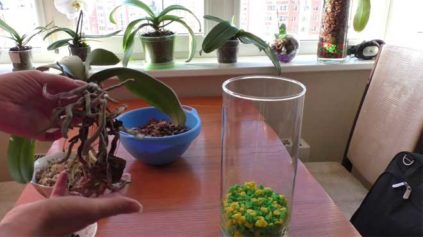
The constant maintenance of orchids in water is accompanied by the formation of a disease, the cause of which is pathogens, for example:
- fungi;
- bacteria.
Pay attention! To prevent problems, it is necessary to properly care for beauties. The ideal microclimate for fungus is a humid and secluded place, for example, a glass vase, in which there is no ventilation. Preventive measures are to periodically ventilate the container.
For epiphytes, air is essential, as it is able to prevent:
Preventive measures include periodic ventilation of the container. For epiphytes, air is essential, as it is able to prevent:
- stagnation of moisture;
- the formation of mold with bacteria.
Phalaenopsis needs water in:
- sufficient lighting;
- maintaining the desired temperature;
- competent watering.
How to care for an orchid in a flask?
Keeping an orchid in a vase has advantages and disadvantages. A humid microclimate is formed and retained behind the glass of the flask, which in turn is very useful for the root system of the epiphyte, since in nature they grow precisely under such conditions.
A significant disadvantage is the rapid cooling of the glass, which can cool the roots. And cold and moisture, as you know, are very harmful to the roots of orchids, they can provoke the appearance of mold and rot.
In addition to the low thermal conductivity of glass, there is its fragility and a high rate of contamination - by limescale, colonies of algae and fungi.
Advice! The disadvantages of glass are leveled by another material - plastic. Even a cut-off plastic bottle may work.
You need to know about all these features of materials and forms before placing a plant in such a container. If this did not stop the grower and a similar experiment is planned, you also need to know about proper care in specific conditions.
Watering
The watering procedure is no different from if the grower did it with a plant in a pot and a pots. It is necessary to carefully pour water into the flask so that all the roots are immersed. After 30-45 minutes, the water must also be carefully drained. Use rainwater, thawed or filtered water with a minimum amount of dissolved mineral salts.
Watering is done in the usual way.
Attention! Be careful when draining the water. The flask can become very slippery, you can drop it and accidentally injure yourself or others by fragments of broken glass .. After draining the water, make sure that it does not remain in the vase
Watering is carried out as needed, depending on the condition and requirements of the plant. On average, this is 2-3 times a week in warm weather and 1 time in cloudy. On especially hot days, the frequency of watering can be daily. Watering is carried out in the morning so that the plant has time to dry out by night
After draining the water, make sure that it does not remain in the vase. Watering is carried out as needed, depending on the condition and requirements of the plant. On average, this is 2-3 times a week in warm weather and 1 time in cloudy. On especially hot days, the frequency of watering can be daily. Watering is carried out in the morning so that the plant has time to dry out by night.
Airing
Fresh air is essential for epiphytes. It is necessary to periodically ventilate the plant.
The size of the container should be sufficient so that the roots of the orchid fit freely inside, can be ventilated, and air easily gets inside.
Flask disinfection
Over time, the glass of the container becomes covered from the inside with a layer of algae, fungi or a coating of salts. For this reason, the flask must be constantly washed and kept clean.
Disinfection can be carried out with a weak solution of potassium permanganate. For the duration of the procedure, pull the plant out of the container.
Sometimes orchid roots stick to the sides of the vase, so be careful when removing it.
Top dressing
Epiphytic orchids in nature feed on humic substances that collect in the cavities of the bark of trees or between stones. In culture, these plants, like no other, need competent feeding.
During the active growing season and a set of green mass, feed the orchid with liquid fertilizers at ¼ of the concentration indicated on the package. Before the procedure, it is necessary to moisten the roots of the plant with clean water - this measure is necessary in order to exclude the possibility of burning the delicate root system with a solution of fertilizers. Such dressings can be alternated with foliar dressings "on the sheet".
Important! Top dressing during the dormant period is sharply reduced or not carried out at all, depending on the type of particular orchid taken.
Disease prevention
The best prevention is keeping the plant in proper conditions and maintaining its hygiene. Care must be taken that the orchid receives a sufficient amount of light, especially in winter, when the length of daylight hours is sharply reduced. Hypothermia of the root system, dirt and debris inside the flask are also unacceptable. Remove dead plant roots and leaves in a timely manner.
Fungicide treatment
It is carried out for prophylactic purposes with systemic fungicides according to the instructions.
Due to improper watering, orchids can rot roots or leaves.
If the plant was nevertheless infected with bacteria or fungi, treatments are carried out in treating dosages.
Basic principles of care
The main operations for caring for an orchid in a vase are watering, feeding, preventing diseases. Reduced labor costs for soil change and replanting.
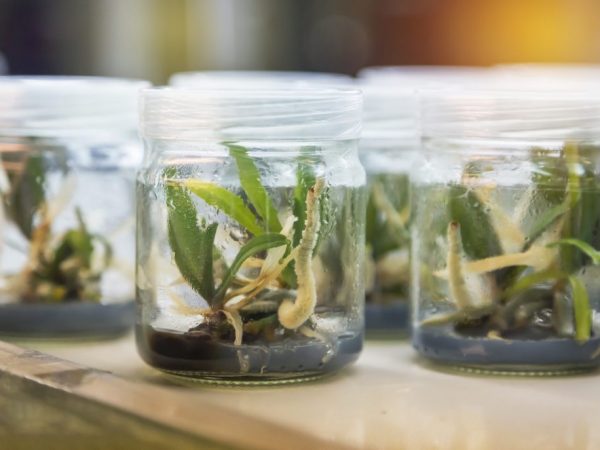
Flasks must be washed regularly
In order for the composition to have a decorative appearance, the flask must be washed from algae and salt deposits about once a month. Plants on hydroculture are taken out once a year, the roots are examined, the salted layer of expanded clay (diatomite) is changed.
Watering
Much attention is paid to the quality of water: ordinary, from the tap, clogged with metal salts, orchidists recommend using rainwater or purified by osmosis with the addition of up to 10% tap water. At home, you can filter water through peat, while excess calcium is removed and excess PH is reduced.
At home, you can filter water through peat, which removes excess calcium and reduces excess PH.
Hydroculture irrigation technique:
- In expanded clay: sprayed on top, then watered with water and fertilizer.
- In perlite, diatomite, green mix: spray abundantly, then gently spill on the inner wall of the vase.
The technique of watering orchids on the block:
- Remove the block from the greenhouse once every 2 weeks;
- immerse in warm water for 10-15 minutes, during the growth period - with fertilizer;
- attach in place.
- if the pot is open, spray the orchid daily.
In winter
Phalaenopsis and Vanda growing in expanded clay can be dried until the roots appear silvery. The roots are examined for decay.
For orchids, resting according to the season, the water in the vase is maintained at a level of up to 1 cm - it does not contain fertilizers, it is added in a thin stream along the inner wall of the pot.
Top dressing
Fertilizers for orchids are applied to irrigation water according to the instructions, without exceeding the dosage. Generally accepted rule:
- during the growth period - 1 ml per 1 liter of water;
- during the rest period - 0.5 ml per 1 liter.
If in doubt, it is better to pour the product in a lower concentration than indicated on the package.
- moderate temperature 20-25 ° C, at night not lower than 18 ° C;
- diffused light;
- timely removal of decayed roots;
- if necessary, spraying against pests, fungicide treatment.
In pots made of natural materials
The cultivation of exotic pets in containers made of natural and other materials is not excluded. The most popular are baskets from:
- Wood;
- Bamboo;
- And even steel;
- Steel mesh;
- Or plastic.
Bamboo is the most successful material in structure. The smooth surface, unlike other wooden materials, does not allow roots to grow into the pores.
Do not differ in decorative appearance and aesthetics of a basket made of steel mesh or plastic. But they are the ones that are practical when growing orchid crops.
Pros and cons, landing features
Advantages:
- Aesthetics and beautiful appearance;
- Environmental friendliness;
- Convenience when creating drainage.
Of the shortcomings, it is worth noting the rather rapid fragility of natural material.
Convenience in the formation of the components of the substrate allows you to conscientiously organize drainage and other components. In the presence of large holes, they should be sealed with sphagnum moss in order to avoid the precipitation of small fractions of soil.
These baskets look beautiful when suspended. The transplanting process itself is not much different from standard methods.
Video "Watering and caring for the Wanda orchid"
In this video, you will learn how to properly care for the Wanda Orchid.
In a vase, which is often presented as a holiday gift, is a simple, albeit a little troublesome business.
Exotic flowers in glass vessels
Orchids are often exported from countries in small, sealed flasks. Glass containers with vandas, phalaenopsis and oncidiums are very effective and compact. By purchasing such an orchid, you can try your hand at being an amateur flower grower. From a small seedling, you can grow a full-fledged adult plant. And if you were presented with an already formed specimen, proper care of the orchid will help prolong its life and preserve the beauty of the flower.

For example, blue wanda looks very stylish and impressive. It has spectacular flowers of an unusual shape. Such an orchid in a vase, the care of which must be constant and competent, can live long enough, delighting others with a healthy look. First, choose a container for the flower. It is best if the vase is wider at the bottom and tapering upward. This will prevent the substrate from losing too much moisture. most often sold in cylindrical flasks. Leaving them in these containers is not very helpful. After all, the lower leaves in such a vessel are in a crumpled position, they can bend and bend. This can generally lead to their withering away. The moisture inside such a cylindrical flask is often excessive and the ventilation is insufficient. This can provoke the growth of bacteria or the appearance of a fungal infection. Roots and leaves affected by this disease are extremely difficult to cure.To counter this, orchid care must include timely replanting. For the first time, this should be done a few months after purchase. Also, caring for orchids involves a special ritual of watering the flower. It must be removed from the flask, immersed in a separate bowl with water for a while. Then, after drying, the orchid is returned back to the vase. To make it easier to care for the flower, position it so that the roots remain inside the container. And the peduncle should be outside.
Miltonia orchid: care and secrets of growing
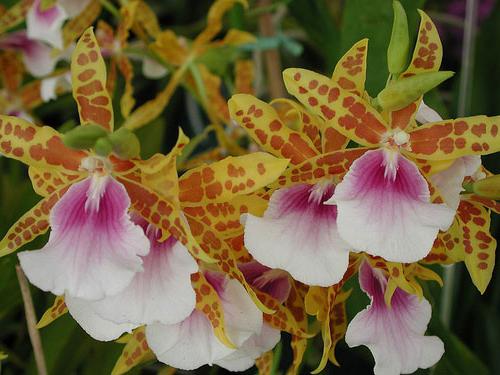
This flower, resembling in shape a flock of huge bright butterflies, is somewhat similar to giant ones.It belongs to the group of oncidiums. Its hybrid varieties are more unpretentious and hardy. Miltonia orchid is an epiphyte. She is originally from Colombia and Brazil. Caring for her is not difficult at all. However, you need to know some rules that you will have to strictly adhere to. The first taboo is about watering. Water procedures need to be done only during the daytime. Evening watering can seriously harm your orchid - after all, the plant cools a little at night. And due to the presence of excess moisture in the pan, the temperature drop may be excessive. The second rule is that water must be boiled and filtered. It should also be warmed up during the cold season. harmful if used for watering. But it is quite suitable for wiping the leaves - due to the absence of some chemical compounds in it, there will be no stains on them.
Vandas of enormous size are often found in flower shops, with a lush beard of roots and bright, large flowers behind the glass of a tall vase.
plants in this form have their own subtleties, advantages and disadvantages,
which you need to know and take into account.
Otherwise, unknowingly, an inexperienced florist can make a number of mistakes, the consequences of which will contribute to the gradual depletion of the plant and its death. Below we will tell you how to grow in clear vases.
Although it looks very elegant in this form, such content is suitable for him very conditionally
... The reason is that only the roots of the plant should be in the flask behind the transparent glass, while the beard should be free to be in space.
Tall vases are not suitable for these purposes.
- the plant should not be completely contained in the container, otherwise it suffers from stuffiness, there is also an increased risk of decay.
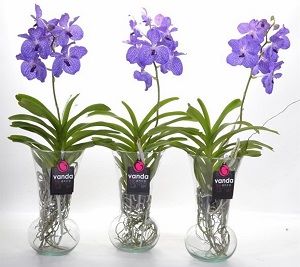
With such a cultivation, the orchid suffers from a lack of air.
Microclimate
As already mentioned, tall, elongated glass for wanda is not suitable, but wide, in the form of glasses are suitable.
The size should be large enough for the roots to fit freely inside. The plant itself from the base of the rosette should be on the surface, flush with the edges of the vase, and not buried inward. You can fix it in this position with a wire.
Attention!
You can grow a vanda in a plastic container. A large, cropped bottle will do.
The use of plastic eliminates the disadvantages of glass - fragility and low thermal conductivity.
Orchid Vanda in glass. Wanda - an orchid of extraordinary beauty
The genus Vanda belongs to the orchid family and includes about 60 species. Among them there are lithophytic species, but for the most part they are epiphytic plants, which determines the specific appearance of the root system - vandas, despite their rather large sizes, grow clinging to tree trunks. The straight stem of this monopodial (with one growth point) flower can reach a height of one meter.
Many of its aerial roots are covered with a layer of velamen. These are dead cells that form a porous, hygroscopic tissue and absorb moisture from the air.
Holding it with their spongy structure, they protect exposed roots from sunburn and create a water reserve, helping the plant survive dry periods without loss. Depending on the climate in which this or that vanda grows, its leaves will be of different colors and degrees of density, more fleshy - in species well adapted to low humidity. Their shape is also different: belt-shaped, roll-shaped (cylindrical) and ovoid. Vanda differs from other types of orchids with flower petals located in the same plane and the absence of pseudobulbs.
Peduncles are found both drooping and erect. The inflorescence is a raceme with several fairly large flowers 9-10 cm in diameter. There are fragrant species. The color of the petals can be very different: from blue-blue to red-orange.
You can often see the so-called network of darker veins. Under favorable conditions, flowering occurs several times a year and lasts up to three months.
Care features
Growing orchids without soil is not a common method for many growers and therefore planting in soil is more popular.
 If we talk about flowers planted in water, then for this it is best to choose the Wanda species. Ordinary phalaenopsis can also be used, but in the wild, Wanda grows on trees or plants, saturated with moisture through rainwater. In order for an orchid in glass of this type to grow at home, you need to maintain an air humidity of at least 60%.
If we talk about flowers planted in water, then for this it is best to choose the Wanda species. Ordinary phalaenopsis can also be used, but in the wild, Wanda grows on trees or plants, saturated with moisture through rainwater. In order for an orchid in glass of this type to grow at home, you need to maintain an air humidity of at least 60%.
In order for an orchid to germinate well in a vase without soil, it is necessary to water it correctly and ensure that the water is at room temperature. Instead of watering, it is advisable to spray the soil, so moisture will not get on the buds and leaves. It should be sprayed depending on the humidity of the air.
If the orchid is in a glass flask, then it must be constantly and carefully looked after:
- In winter, the air temperature should be around 25 degrees. Reduce by 10 degrees if kidney formation is needed.
- Humidity must be maintained up to 75%. This makes the cultivation of orchids problematic, because it is very difficult to recreate the necessary moisture. But for many species, it is possible to maintain an indicator of 40%, since the orchid will take the missing moisture from evaporation due to high humidity.
- The orchid prefers fresh air, but should not be installed in a ventilated area. In summer, the flower can be placed on the balcony in the shade, where direct sunlight will not fall, as they can burn the leaves.
- The water with growing phalaenopsis is changed every 3 days, and the pot itself is washed well once a month. During this, the roots of the plant are wiped, dried, and then dipped into a new solution.
- From time to time, the flower grows new leaves, but does not bloom during this period. To provoke flowering, you need to make a slight difference in day and night temperatures.
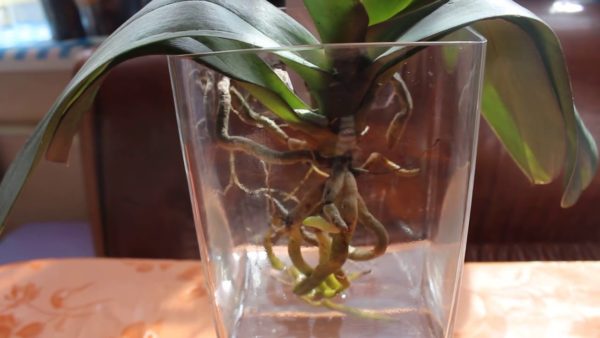 Water the grown orchid in a glass container in the same way as in a plastic pot:
Water the grown orchid in a glass container in the same way as in a plastic pot:
You need to add water to the roots so that they are completely immersed in it. The water itself must be infused to room temperature.
It is important that it is free of impurities, or at least with their minimum amount.
Attention! The high content of mineral salts harms the phalaenopsis root system, leaves a white coating on the walls of the glass pot, which does not look very nice.
In warm weather, water the plant 3 times a week, and in cool weather only once every seven days. But in hot weather, the frequency of watering can increase to daily. It is best to do it in the morning or at lunchtime, so that the orchid has time to dry in the evening.
When the orchid begins to overgrow with leaves and grow actively, it needs to be fed with liquid fertilizers once a week according to the instructions. Before dipping the roots of the flower in the nutrient solution, they must be dipped in water so that a burn does not occur. Such top dressing alternates with fertilizers for green mass from a spray bottle.
How to care?
To get a beautiful plant when planting seedlings, the following rules must be observed:
- purchasing only healthy specimens;
- preparation of a special planting mixture;
- the creation of a drainage system;
- moderate and timely watering.
Before planting an orchid in a glass pot, you must thoroughly wash and sterilize the container. The following types of drainage material must be laid at the bottom of the container:
- expanded clay;
- gravel;
- fragments of stone and brick;
- pebbles.

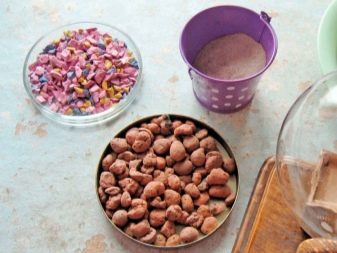
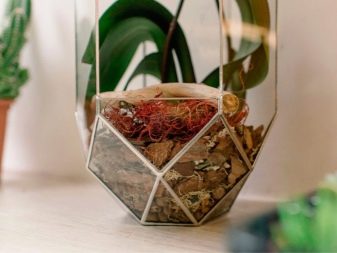
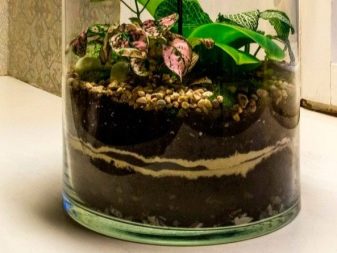
The prepared container with drainage should be poured with warm water for 30 minutes, which must be drained before planting the flower. It is necessary to cover the entire area near the root collar with wet pieces of moss.
Positive aspects of the lack of a substrate:
- prevention of decay of the root system;
- lack of pests;
- free supply of oxygen to the roots;
- no need to carry out a transplant;
- maximum production of nutrients from the water by the plant.
Direct plant care consists of the following steps:
- watering;
- top dressing;
- airing;
- disinfection.
To water this type of plant, it must be immersed in clean, settled water at room temperature for 30 minutes. It is strictly forbidden to immerse the neck and leaves in the liquid. Experts recommend replacing watering with spraying. In winter, this procedure must be carried out daily, and in summer it is enough to moisturize the root system 2-3 times a week.

Large plants can be watered directly in a flask, into which a small amount of prepared water must be poured, and after a few minutes, the excess liquid must be carefully drained. Moisture deficiency indicator - color change of the root system
If the roots have acquired a brown tint, it is necessary to quickly begin to restore the water balance of the plant.
Like any plant, orchids need feeding. Mineral fertilizers corresponding to the type of plant must be dissolved in water for irrigation according to the manufacturer's instructions. It has a positive effect on the flower and foliar feeding.

Due to the impossibility of air circulation in the glass container, as well as high humidity, it is necessary to periodically ventilate the plant in it. To carry out this event, it is enough just to leave the flower in the open air for a while.
For disinfection, you can use "Fitosporin", some types of antibiotics and fungicides. In the case of a weak root system, gardeners recommend immersing the plant in Kornevin's solution or other stimulants for the growth of the root system. To prevent the formation of salt deposits, it is necessary to regularly process the glass container with a weak solution of potassium permanganate.
To maintain a high aesthetic level, florists recommend timely removal of yellow and dry leaves, monitor the possible appearance of parasites, provide a comfortable temperature regime and a sufficient level of illumination. Professional gardeners recommend following these guidelines when growing an orchid:
- placing a flowerpot on the windowsills on the north side;
- protection of the flower from direct sunlight;
- using only transparent containers that will ensure the maximum level of photosynthesis;
- pieces of pine bark are the best type of substrate that retains moisture well and has a decorative look;
- as the plant grows and the upper leaves wither, it is necessary to add a substrate;
- immersion of a plant in cold water can lead to its disease;
- if water gets into the leaf axils, it is necessary to quickly remove the liquid with a dry cloth to prevent the development of putrefactive processes;
- frequent watering is the reason for the appearance of cracks in the foliage, and rare moisture of the plant will lead to wrinkling and wilting of the leaves;
- for feeding, it is advisable to use ready-made complexes of mineral fertilizers;
- the frequency of application of mineral fertilizers depends on the time of year: in the summer - 2 times a week, in the winter - once a week;
- to exclude deformation of the trunk, it is necessary to regularly change the location of the plant relative to the sun;
- during the formation of the bud, it is necessary to attach a support to the trunk to avoid its deformation;
- the optimal difference between day and night temperatures is 6 degrees;
- mandatory use of artificial lighting in winter;
- dry peduncles must be removed.

The brought bouquet must be carefully removed from the container, cut off the stems and placed in a vase of warm water with a few drops of alcohol or vodka. The most suitable place is a shady place without heating appliances


